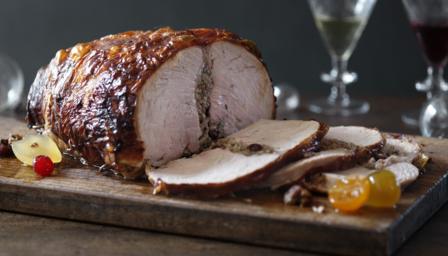Turkey breast stuffed with Italian sausage and Marsala-steeped cranberries

Method
-
Put the cranberries and Marsala into a small saucepan and bring to a boil, then take off the heat and leave to one side.
-
Put the oil into a large frying pan or similar heavy-based pan, and fry the shallots for a minute or so, then add the spices and shredded sage, turning them in the soft shallots.
-
Squeeze the sausagemeat out of its skins, add to the pan and break it up – using a wooden fork and spatula for ease – turning it in the hot pan until it loses its pinkness. This will take about five minutes.
-
Take the frying pan off the heat and turn the contents into a large bowl, mixing in the steeped cranberries and any Marsala clinging to them, and leave to cool. You can cover with cling film and put in the fridge for up to two days at this stage.
-
When you are ready to stuff the turkey breast, take the bowl of sausagement out of the fridge.
-
Preheat the oven to 200C/400F/Gas 6.
-
Uncover the bowl of sausagemeat, add the eggs, parmesan and breadcrumbs and – I use my hands for this – mix well.
-
Lay the butterflied turkey joint out in front of you. It really does look like a butterfly though admittedly a fleshy one. Spread the stuffing out first in the slight cavity in the centre of the butterfly and then outwards onto the wings though not going right up to the edge (or it will squodge out when cooking) but as evenly as possible over the whole joint.
-
Carefully, in one swift but steady movement, fold one ‘wing’ over the other to close the joint, and then sit the turkey on a large roasting tin, breast bone (or where the breast bone would be) uppermost as it would look were it the whole bird, with the pointier bit furthest away from you. Thread two skewers through the base – i.e., the widest part that is nearer you – to keep it closed and smear it all over with the duck or goose fat.
-
Roast the turkey breast for 2-2½ hours, then check it is cooked with a turkey or meat thermometer. When cooked, it should read 75C. (If you’re leaving it to rest, as you should or to cool, you could take it out at 73C – it wil retain heat and continue to cook for a short while once out of the oven.)
-
Flex your muscles, then lift out onto a carving board, and leave to rest for at least 20 minutes. Or leave to get cold if you are eating it as part of a buffet.
-
Cut through the whole joint in wide slices right across; they will need to be quite thick, at least 1-2cm/½-1in, to keep the stuffing intact within the slice.
-
As you place it on table or sideboard, dot around it the condiments of your choice: I revert to Christmas in Italy here by putting a lusciously extravagant pot or two of Italian mostarda di Cremona on the table alongside: this is a hot and sweet preserve of mustardy candied fruits that gleam beautifully and taste both festive and fabulous.
Ingredients
For the stuffing
- 100g/3½oz dried cranberries
- 100ml/3½fl oz Marsala
- 2 tbsp olive oil
- 2 banana shallots, finely chopped
- ¼ tsp ground cloves
- ½ tsp ground allspice
- 2 tsp chopped fresh sage
- 1kg/2lb 4oz Italian sausages
- 2 free-range eggs, beaten
- 50g/2oz parmesan, grated
- 60g/2¼oz breadcrumbs
For the turkey joint
- 5kg/11lb double breast turkey joint, boned, butterflied, with skin left on
- 4 tbsp duck or goose fat
Shopping List
Turkey breast stuffed with Italian sausage and Marsala-steeped cranberries
Fruit and vegetables
Cooking ingredients
Dairy, eggs and chilled
Meat, fish and poultry
Other